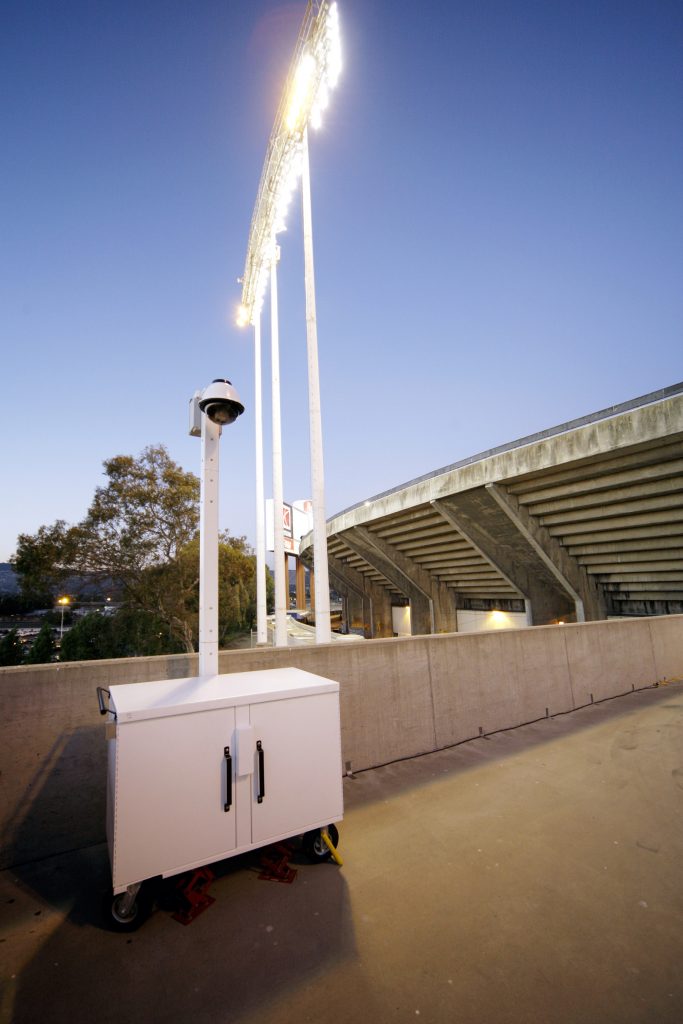
Download 300dpi JPEG image, “node.jpg,” 740K (Media are welcome to download/publish this image with related news stories.)
LIVERMORE, Calif. — Baseball fans cheering on their beloved Oakland A’s in a recent homestand may have been happy about the team’s play, but the best news for those visitors to McAfee Stadium didn’t take place on the field and couldn’t be noticed by even the most observant spectators.
Through late June and early July, researchers from Sandia National Laboratories in Livermore — roughly 30 minutes east of the A’s home of McAfee Stadium — tested the Rapidly Deployable Chemical Detection System (RDCDS) during a series of games. The system, which can be packaged and deployed within 24 hours locally, has been funded by the Department of Homeland Security and is designed to provide swift yet effective protection at high-profile events.
Sandia is a National Nuclear Security Administration laboratory.
RDCDS is designed to provide broad, high-confidence coverage of more than 40 different chemicals using multiple overlapping detection technologies and live video. “The beauty of this system is that it can be packaged and set up at a venue within a day’s notice, without having to sacrifice any of the robustness or features required by such a sophisticated system,” said Ben Wu, a chemical engineer at Sandia who serves as project manager for RDCDS. “The bottom line is that it can help emergency responders save more lives in the event of a terrorist attack.”
RDCDS can detect a variety of chemical warfare agents as well as the more common toxic industrial chemicals. The RDCDS platform will also readily accept other types of detectors, such as those that sense radiological material. As a “detect-to-warn” system, said Wu, the aim of RDCDS is to alert emergency responders to a chemical release early on and enable evacuations or other timely response measures to minimize casualties.
Mix of detection and surveillance measures
A 2004 version of RDCDS (then known simply as Sensor Management Architecture) utilized just one “node,” e.g., a box laden with electronic components, detectors, and communications equipment, and a total of just two detectors. The RDCDS system has matured to the point that eight nodes, totaling some 64 detectors, were networked in and around McAfee Stadium during the Oakland deployment.
The detectors, said Wu, use a variety of technologies and capabilities in order to counter any attempts by outside forces or terrorists to tamper with the system, and simply to avoid having to rely too heavily on any one detector. Detectors are placed strategically and, depending on wind trajectory and other environmental variables, might even be placed outside a venue’s physical boundaries.
The system also incorporates video surveillance cameras, which serve both to confirm the findings of the detection equipment and to keep a lookout for illicit attempts to damage or alter any system components.

Download 300dpi JPEG image, “mcafee-stadium.jpg,” 788K (Media are welcome to download/publish this image with related news stories.)
Primary challenge is “background noise”
In designing and testing the RDCDS system, said Wu, the main obstacle has been in dealing with the plethora of “background noise” common in or near large venues — one reason why Sandia’s team appreciated McAfee Stadium management allowing a multi-game test deployment there.
“You simply can’t reproduce in a laboratory the kind of real-world environment in which RDCDS is meant to be deployed,” Wu said.
In a typical sports venue such as McAfee, he said, detectors must try to differentiate between authentic chemical releases and cigarette smoke, automobile emissions, perfumes, odors from popcorn machines, hamburger stands, and hot dog vendors.
In addition to the deployment at McAfee Stadium, Sandia evaluated RDCDS’s effectiveness during a 10-week stint at Sandia’s Livermore site and at a brief deployment at San Francisco International Airport in early 2005.